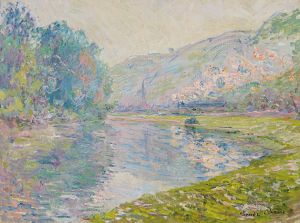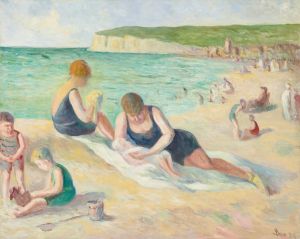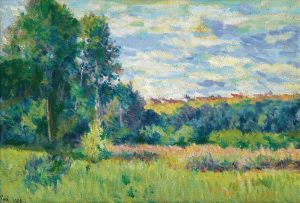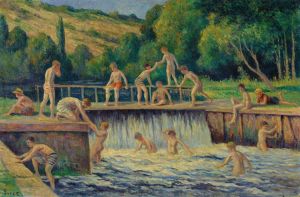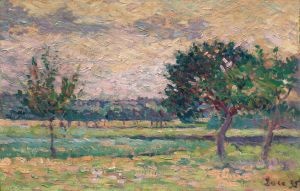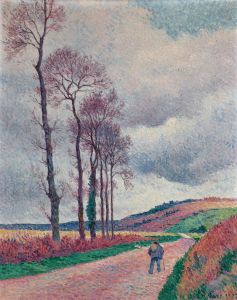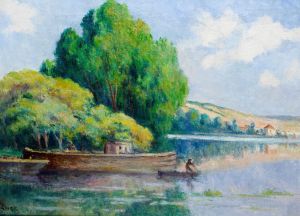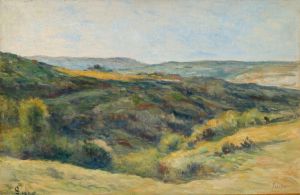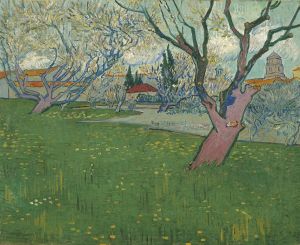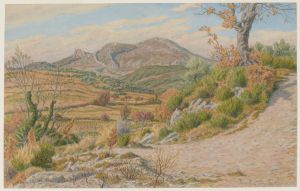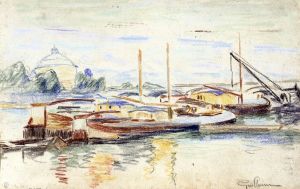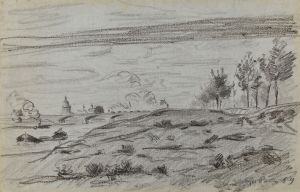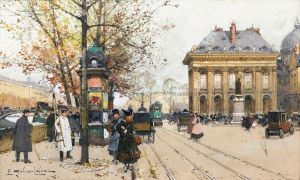
Rolleboise, baigneurs près du bras de Seine
A hand-painted replica of Maximilien Luce’s masterpiece Rolleboise, baigneurs près du bras de Seine, meticulously crafted by professional artists to capture the true essence of the original. Each piece is created with museum-quality canvas and rare mineral pigments, carefully painted by experienced artists with delicate brushstrokes and rich, layered colors to perfectly recreate the texture of the original artwork. Unlike machine-printed reproductions, this hand-painted version brings the painting to life, infused with the artist’s emotions and skill in every stroke. Whether for personal collection or home decoration, it instantly elevates the artistic atmosphere of any space.
Maximilien Luce was a prominent French Neo-Impressionist artist known for his vibrant use of color and light, and his works often depicted scenes of everyday life and landscapes. One of his notable paintings is "Rolleboise, baigneurs près du bras de Seine" (translated as "Rolleboise, Bathers near the Arm of the Seine"). This painting exemplifies Luce's mastery in capturing the serene beauty of the French countryside and the leisurely activities of its inhabitants.
Created during a period when Luce was deeply influenced by the Neo-Impressionist movement, the painting showcases his skillful application of the pointillist technique, a method characterized by the use of small, distinct dots of color applied in patterns to form an image. This technique was pioneered by Georges Seurat and Paul Signac, and Luce became one of its most adept practitioners. The pointillist style allowed Luce to explore the effects of light and color in a way that was both scientific and aesthetically pleasing.
"Rolleboise, baigneurs près du bras de Seine" depicts a tranquil scene along the Seine River, near the village of Rolleboise, located in the Île-de-France region. The painting captures a group of bathers enjoying a leisurely day by the riverbank, a common pastime during the warmer months. The Seine River, with its gentle flow and picturesque surroundings, has long been a source of inspiration for artists, and Luce's depiction adds to this rich tradition.
In this work, Luce employs a palette of soft blues, greens, and earthy tones to convey the peacefulness of the scene. The shimmering surface of the water reflects the light of the sky, creating a harmonious balance between the natural elements. The figures of the bathers are integrated into the landscape, emphasizing the connection between humans and nature. Luce's attention to detail and his ability to capture the ephemeral qualities of light are evident in the way the sunlight filters through the trees and dances on the water's surface.
The painting is not only a testament to Luce's technical prowess but also reflects his interest in the social and cultural aspects of his time. By choosing to depict ordinary people engaged in simple pleasures, Luce aligns himself with the broader Impressionist and Post-Impressionist movements, which sought to portray contemporary life in all its facets. His work often carried subtle social commentary, highlighting the dignity and beauty of everyday experiences.
Maximilien Luce's "Rolleboise, baigneurs près du bras de Seine" remains a significant piece within his oeuvre and the broader context of Neo-Impressionism. It exemplifies the movement's ideals of capturing the transient effects of light and color while also celebrating the simple joys of life. Today, Luce's works are appreciated for their artistic innovation and their ability to convey the essence of a moment in time, making them enduring contributions to the world of art.





